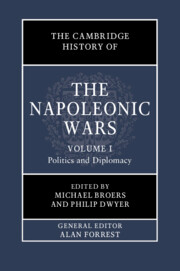Book contents
- The Cambridge History of the Napoleonic Wars
- The Cambridge History of the Napoleonic Wars
- The Cambridge History of the Napoleonic Wars
- Copyright page
- Contents
- Figures and Tables
- Maps
- Contributors to Volume I
- Acknowledgements
- General Introduction
- Introduction to Volume I
- Part I The Origins of the Napoleonic Wars
- Part II Napoleon and his Empire
- Part III War Aims
- 14 French Preponderance and the European System
- 15 Habsburg Grand Strategy in the Napoleonic Wars
- 16 Prussian Foreign Policy and War Aims, 1790–1815
- 17 British War Aims, 1793–1815
- 18 Alexander I’s Objectives in the Franco-Russian Wars, 1801–1815
- 19 Ottoman War Aims
- 20 Spain and Portugal
- 21 War Aims: Scandinavia
- Bibliographical Essays
- Index
16 - Prussian Foreign Policy and War Aims, 1790–1815
from Part III - War Aims
Published online by Cambridge University Press: 13 October 2022
- The Cambridge History of the Napoleonic Wars
- The Cambridge History of the Napoleonic Wars
- The Cambridge History of the Napoleonic Wars
- Copyright page
- Contents
- Figures and Tables
- Maps
- Contributors to Volume I
- Acknowledgements
- General Introduction
- Introduction to Volume I
- Part I The Origins of the Napoleonic Wars
- Part II Napoleon and his Empire
- Part III War Aims
- 14 French Preponderance and the European System
- 15 Habsburg Grand Strategy in the Napoleonic Wars
- 16 Prussian Foreign Policy and War Aims, 1790–1815
- 17 British War Aims, 1793–1815
- 18 Alexander I’s Objectives in the Franco-Russian Wars, 1801–1815
- 19 Ottoman War Aims
- 20 Spain and Portugal
- 21 War Aims: Scandinavia
- Bibliographical Essays
- Index
Summary
In the four decades before his death in 1786, Frederick the Great pulled off one of the most impressive bluffs in European history: he elevated a small, poor and underpopulated collection of provinces to the status of a European great power using few resources other than intellectual gravitas and military prowess. Of the five major states with ambitions in Central Europe, Prussia was undeniably the weakest, with no fleet or overseas empire, with no great financial centres, and with a sprawling, disconnected crescent of territories stretching from present-day Lithuania to the Dutch border, most of which was flat and indefensible. In 1800 the Prussian kingdom had less than one third the population of France or Russia, and only a small fraction of the wealth of Britain. Frederick’s old rivals the Habsburgs ruled more than twice as many subjects and held at least theoretical leadership of nearly twenty million Germans in the Holy Roman Empire.
- Type
- Chapter
- Information
- The Cambridge History of the Napoleonic Wars , pp. 332 - 351Publisher: Cambridge University PressPrint publication year: 2022

